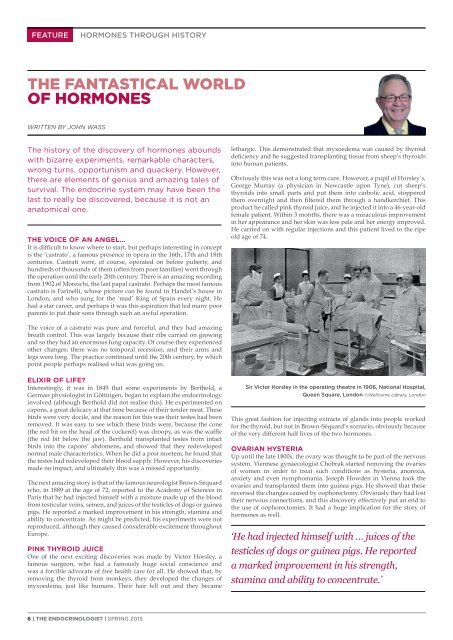1CIShci
1CIShci
1CIShci
Create successful ePaper yourself
Turn your PDF publications into a flip-book with our unique Google optimized e-Paper software.
FEATURE<br />
HORMONES THROUGH HISTORY<br />
THE FANTASTICAL WORLD<br />
OF HORMONES<br />
WRITTEN BY JOHN WASS<br />
The history of the discovery of hormones abounds<br />
with bizarre experiments, remarkable characters,<br />
wrong turns, opportunism and quackery. However,<br />
there are elements of genius and amazing tales of<br />
survival. The endocrine system may have been the<br />
last to really be discovered, because it is not an<br />
anatomical one.<br />
THE VOICE OF AN ANGEL…<br />
It is difficult to know where to start, but perhaps interesting in concept<br />
is the ‘castrato’, a famous presence in opera in the 16th, 17th and 18th<br />
centuries. Castrati were, of course, operated on before puberty, and<br />
hundreds of thousands of them (often from poor families) went through<br />
the operation until the early 20th century. There is an amazing recording<br />
from 1902 of Moreschi, the last papal castrato. Perhaps the most famous<br />
castrato is Farinelli, whose picture can be found in Handel’s house in<br />
London, and who sung for the ‘mad’ King of Spain every night. He<br />
had a star career, and perhaps it was this aspiration that led many poor<br />
parents to put their sons through such an awful operation.<br />
lethargic. This demonstrated that myxoedema was caused by thyroid<br />
deficiency and he suggested transplanting tissue from sheep’s thyroids<br />
into human patients.<br />
Obviously this was not a long term cure. However, a pupil of Horsley’s,<br />
George Murray (a physician in Newcastle upon Tyne), cut sheep’s<br />
thyroids into small parts and put them into carbolic acid, stoppered<br />
them overnight and then filtered them through a handkerchief. This<br />
product he called pink thyroid juice, and he injected it into a 46-year-old<br />
female patient. Within 3 months, there was a miraculous improvement<br />
in her appearance and her skin was less pale and her energy improved.<br />
He carried on with regular injections and this patient lived to the ripe<br />
old age of 74.<br />
The voice of a castrato was pure and forceful, and they had amazing<br />
breath control. This was largely because their ribs carried on growing<br />
and so they had an enormous lung capacity. Of course they experienced<br />
other changes; there was no temporal recession, and their arms and<br />
legs were long. The practice continued until the 20th century, by which<br />
point people perhaps realised what was going on.<br />
ELIXIR OF LIFE?<br />
Interestingly, it was in 1849 that some experiments by Berthold, a<br />
German physiologist in Göttingen, began to explain the endocrinology<br />
involved (although Berthold did not realise this). He experimented on<br />
capons, a great delicacy at that time because of their tender meat. These<br />
birds were very docile, and the reason for this was their testes had been<br />
removed. It was easy to see which these birds were, because the cone<br />
(the red bit on the head of the cockerel) was droopy, as was the waffle<br />
(the red bit below the jaw). Berthold transplanted testes from intact<br />
birds into the capons’ abdomens, and showed that they redeveloped<br />
normal male characteristics. When he did a post mortem, he found that<br />
the testes had redeveloped their blood supply. However, his discoveries<br />
made no impact, and ultimately this was a missed opportunity.<br />
The next amazing story is that of the famous neurologist Brown-Séquard<br />
who, in 1889 at the age of 72, reported to the Academy of Sciences in<br />
Paris that he had injected himself with a mixture made up of the blood<br />
from testicular veins, semen, and juices of the testicles of dogs or guinea<br />
pigs. He reported a marked improvement in his strength, stamina and<br />
ability to concentrate. As might be predicted, his experiments were not<br />
reproduced, although they caused considerable excitement throughout<br />
Europe.<br />
PINK THYROID JUICE<br />
One of the next exciting discoveries was made by Victor Horsley, a<br />
famous surgeon, who had a famously huge social conscience and<br />
was a forcible advocate of free health care for all. He showed that, by<br />
removing the thyroid from monkeys, they developed the changes of<br />
myxoedema, just like humans. Their hair fell out and they became<br />
Sir Victor Horsley in the operating theatre in 1906, National Hospital,<br />
Queen Square, London ©Wellcome Library, London<br />
This great fashion for injecting extracts of glands into people worked<br />
for the thyroid, but not in Brown-Séquard’s scenario, obviously because<br />
of the very different half lives of the two hormones.<br />
OVARIAN HYSTERIA<br />
Up until the late 1800s, the ovary was thought to be part of the nervous<br />
system. Viennese gynaecologist Chobrak started removing the ovaries<br />
of women in order to treat such conditions as hysteria, anorexia,<br />
anxiety and even nymphomania. Joseph Howden in Vienna took the<br />
ovaries and transplanted them into guinea pigs. He showed that these<br />
reversed the changes caused by oophorectomy. Obviously they had lost<br />
their nervous connections, and this discovery effectively put an end to<br />
the use of oophorectomies. It had a huge implication for the story of<br />
hormones as well.<br />
‘He had injected himself with … juices of the<br />
testicles of dogs or guinea pigs. He reported<br />
a marked improvement in his strength,<br />
stamina and ability to concentrate.’<br />
6 | THE ENDOCRINOLOGIST | SPRING 2015


